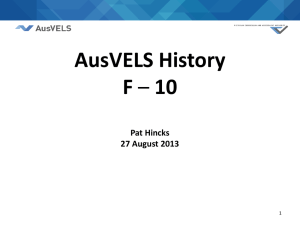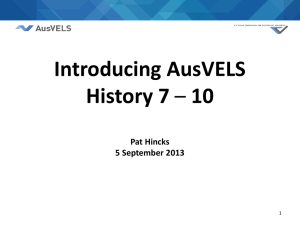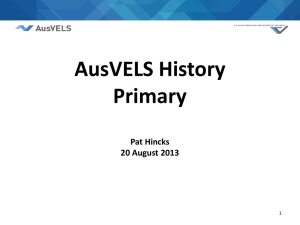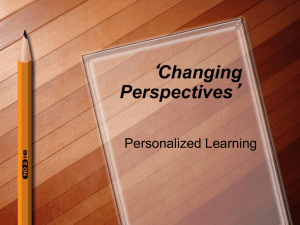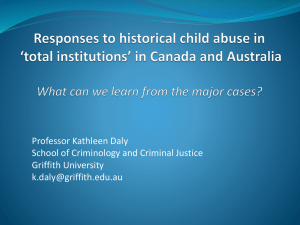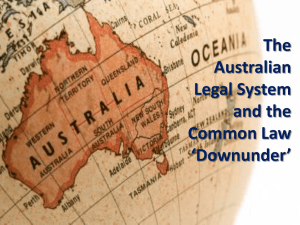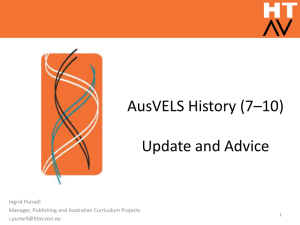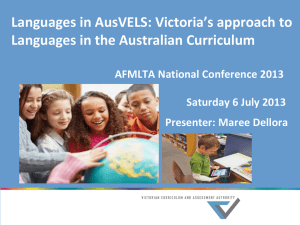AusVELS History F – 10 - Victorian Curriculum and Assessment
advertisement
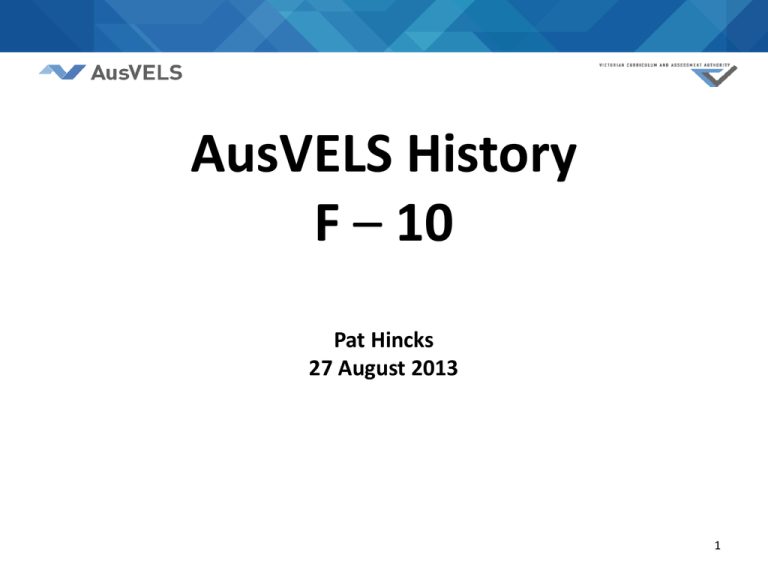
AusVELS History F – 10 Pat Hincks 27 August 2013 1 History: Common questions • • • • • Is there a mandated time? Does it have to be taught for a whole year? What is the status of the elaborations? What about multi-age/ composite classes? Can we ‘integrate’ history with other subjects? • How can we fit it into a ‘crowded curriculum’? 2 History and time allocation There is no time allocation which is mandated for AusVELS History. However: History F – 2 was written for 20 hours a year History 3 – 6 was written for 40 hours a year History 7 – 10 was written for 50 hours a year Source: Curriculum Design Paper, ACARA, http://www.acara.edu.au/curriculum/curriculum_design_and_development.html 3 Curriculum – not pedagogy Jurisdictions, systems and schools will be able to implement the Australian Curriculum in ways that value teachers’ professional knowledge, reflect local contexts and take into account individual students’ family, cultural and community backgrounds. Schools and teachers determine pedagogical and other delivery considerations. (Source: The Shape of the Australian Curriculum, ACARA, www.acara.edu.au ) 4 Humanities and Social Sciences Curriculum History Geography Civics and Citizenship Economics and Business F-2 20 hours per year 20 hours per year NIL NIL 3-4 40 hours per year 40 hours per year 20 hours per year NIL 5-6 40 hours per year 40 hours per year 20 hours per year 20 hours per year 7-8 50 hours per year 50 hours per year 20 hours per year 20 hours per year 9-10 50 hours per year 50 hours per year 20 hours per year 50 hours per year 5 Rationale Depth Studies Knowledge Content descriptions Elaborations Level descriptions Achievement standards Cross curriculum priorities Aims Skills Understanding Overviews Concepts 6 RATIONALE: History is a disciplined process of inquiry into the past that develops students' curiosity and imagination. Awareness of history is an essential characteristic of any society, and historical knowledge is fundamental to understanding ourselves and others. It promotes the understanding of societies, events, movements and developments that have shaped humanity from earliest times. It helps students appreciate how the world and its people have changed, as well as the significant continuities that exist to the present day. History, as a discipline, has its own methods and procedures which make it different from other ways of understanding human experience. The study of history is based on evidence derived from remains of the past. It is interpretative by nature, promotes debate and encourages thinking about human values, including present and future challenges. The process of historical inquiry develops transferable skills, such as the ability to ask relevant questions; critically analyse and interpret sources; consider context; respect and explain different perspectives; develop and substantiate interpretations, and communicate effectively. 7 AIMS: The Australian Curriculum: History aims to ensure that students develop: • interest in, and enjoyment of, historical study for lifelong learning and work, including their capacity and willingness to be informed and active citizens • knowledge, understanding and appreciation of the past and the forces that shape societies, including Australian society • understanding and use of historical concepts, such as evidence, continuity and change, cause and effect, perspectives, empathy, significance and contestability • capacity to undertake historical inquiry, including skills in the analysis and use of sources, and in explanation and communication. 8 History: Structure Primary AusVELS History Explanations Level Descriptions a) Overview of the level Content b) Key concepts of history understanding c) Key inquiry questions a) What will be taught at that level b) Continuity and change, cause and effect, perspectives, empathy and significances, Sources c) Inquiry questions frame teaching and learning for that year Content Descriptions a) Historical knowledge and understanding b) Historical skills Knowledge and understanding strands are year by year Historical skills strands are in a three level band from F – 2 and then in two level bands Achievement Standards Focus on understanding and skills Describe what students know and can do at each level 9 History: Structure Secondary AusVELS History Explanations Level Descriptions a) Overview of the Y level Content b) Key concepts of history understanding c) Key inquiry questions a) What will be taught at that level b) Continuity and change, cause and effect, perspectives, empathy and significances, evidence, contestability c) Inquiry questions frame teaching and learning for that level Content Descriptions a) Historical knowledge and understanding Overview Depth Studies b) Historical skills Knowledge and understanding strands are level by level Historical skills strands in two level bands Overviews provide a context for the level Varying choice in Depth Studies Achievement Standards Focus on understanding and skills Describe what students know and can do at each level 10 Historical sequence Level Content Level F Personal and Family Histories Level 1 Level 2 Present and Past Family The Past in the Present Life The Foundation curriculum provides a study of personal and family histories. Students learn about their own history and that of their family The Level 1 curriculum provides a study of present and past family life within the context of the students’ own world. The Level 2 curriculum provides a study of local history. Concepts of historical understanding continuity and change, cause and effect, perspectives, empathy and significance Key questions What is my history and how do I know? How has family life changed or remained the same over time? What aspects of the past can you see today? What do they tell us? What stories do other people tell about the past? How can we show that the present is different from or similar to the past? What remains of the past are important to the local community? Why? How can stories of the past be told and shared? How do we describe the sequence of time? How have changes in technology shaped our daily life? 11 Level Content Level 3 Community and Remembrance Level 4 First Contacts The Level 3 curriculum provides a study of identity and diversity in both a local and broader context…. students explore the historical features and diversity of their community as represented in symbols and emblems of significance, and celebrations and commemorations… The Level 4 curriculum introduces world history and the movement of peoples. Beginning with the history of Aboriginal and Torres Strait Islander peoples, students examine European exploration and colonisation in Australia and throughout the world up to the early 1800s. Concepts of historical understanding sources, continuity and change, cause and effect, perspectives, empathy and significance. Key questions Who lived here first and how do we know? Why did the great journeys of exploration occur? How has our community changed? What features have been lost and what features have been retained? What was life like for Aboriginal and/or Torres Strait Islander Peoples before the arrival of the Europeans? What is the nature of the contribution made by different groups and individuals in the community? Why did the Europeans settle in Australia? How and why do people choose to remember significant events of the past? What was the nature and consequence of contact between Aboriginal and/or Torres Strait Islander Peoples and early traders, explorers and settlers? 12 Level Content Level 5 The Australian Colonies Level 6 Australia as a nation Level 5 curriculum provides a study of colonial Australia in the 1800s. Students look at the founding of British colonies and the development of a colony. Level 6 [covers] the development of Australia as a nation, particularly after 1900. Students explore the factors that led to Federation and experiences of democracy and citizenship over time…. Students learn about the way of life of people who migrated to Australia and their contributions…. Concepts of historical understanding sources, continuity and change, cause and effect, perspectives, empathy and significance. Key questions What do we know about the lives of people in Australia’s colonial past and how do we know? Why and how did Australia become a nation? How did an Australian colony develop over time and why? How did Australian society change throughout the twentieth century? How did colonial settlement change the environment? Who were the people who came to Australia? Why did they come? What were the significant events and who were the significant people that shaped Australian colonies? What contribution have significant individuals and groups made to the development of Australian society? 13 Level Content Level 7 The Ancient World Level 8 The Ancient to the Modern World The Level 7 curriculum provides a study of history from the time of the earliest human communities to the end of the ancient period, approximately 60,000BC (BCE)– c. 650AC (CE)…. a range of societies including Australia, Egypt, Greece, Rome, China and India. The Level 8 curriculum provides a study of history from the end of the ancient period to the beginning of the modern period c650AD (CE) – 1750. …when major civilisations around the world came into contact with each other. Social, economic, religious and political beliefs were often challenged and significantly changed. Concepts of historical understanding evidence, continuity and change, cause and effect, perspectives, empathy, significance and contestability Key questions How do we know about the ancient past? Why and where do the first human communities develop? What emerged as the defining characteristics of ancient societies? How did societies change from the end of the ancient period to the beginning of the modern age? What key beliefs and values emerged and how did they influence societies? What were the causes and effects of contact between societies in this period? What have been the legacies of ancient societies? Which significant people, groups and ideas from this period have influenced the world today? 14 Level Content Concepts of historical understanding Key questions Level 9 The Making of the Modern World Level 10 The Modern World and Australia The Level 9 curriculum provides a study of the making of the modern world from 1750 to 1918. It was a period of industrialisation and rapid change in the way people lived, worked and thought. It was an era of nationalism and imperialism and the colonisation of Australia….culminated in WW1… The Level 10 curriculum provides a history of the modern world and Australia from 1918 to the present with an emphasis on Australia in its global context….became a critical period in Australia’s social, cultural, economic and political development…..a time of political turmoil, global conflict and international cooperation…Australia’s place. evidence, continuity and change, cause and effect, perspectives, empathy, significance and contestability How did the nature of global conflict change during the twentieth century? What were the consequences of World War II? How did these consequences shape the modern world? How was Australian society affected by other significant global events and changes in this period? How did the nature of global conflict change during the twentieth century? What were the consequences of World War II? How did these consequences shape the modern world? How was Australian society affected by other significant global events and changes during this period? 15 Historical understanding • Continuity and change: aspects of the past that remained the same over certain periods of time and aspects that are different • Cause and effect used by historians to identify chains of events and developments over time (understanding of motivation and consequences). • Perspectives: understanding the different social, cultural and intellectual contexts that shaped people’s lives and actions in the past and the various viewpoints on past events. • Empathy: understanding of the past from the point of view of a particular individual or group, including an appreciation of the circumstances they faced, and the motivations, values and attitudes behind their actions 16 Historical understanding • Significance: the importance that is assigned to particular aspects of the past, eg events, developments, movements and historical sites. • Sources: artefacts, photos, artworks, letters and accounts etc of the past produced at the time primary and afterwards secondary • Evidence: information obtained from sources that is valuable for a particular inquiry • Contestability: occurs when particular interpretations about the past are open to debate, for example, as a result of a lack of evidence or different perspectives 17 Elaborations 18 Skills F-2 3-4 5-6 Sequence historical people and events Use historical terms Sequence historical people and events Use historical terms and concepts Pose a range of questions about the past Identify questions to inform an historical inquiry Identify and locate a range of relevant sources Locate relevant information from sources provided Locate information related to inquiry questions in a range of sources Compare information from a range of sources Identify different points of view Identify points of view in the past and present Develop a narrative about the past Develop historical texts, particularly narratives Develop historical texts, particularly narratives and descriptions, which incorporate source material Use a range of communication forms (oral, graphic, written, role play) and digital technologies Use a range of communication forms (oral, graphic, written) and digital technologies Chronology, terms and concepts Sequence familiar objects and events Distinguish between the past, present and future Historical questions and research Pose questions about the past using sources provided Analysis and use of sources Explore a range of sources about the past Identify and compare features of objects from the past and present Perspectives and interpretations Explore a point of view Explanation and communication Use a range of communication forms (oral, graphic, written) and digital technologies 19 Skills 7-8 9 - 10 Chronology, terms and concepts Sequence historical events, developments and periods Use historical terms and concepts Use chronological sequencing to demonstrate the relationship between events and developments in different periods and places Use historical terms and concepts Historical questions and research Identify a range of questions about the past to inform an historical inquiry Identify and locate relevant sources, using ICT and other methods Identify and select different kinds of questions about the past to inform an historical inquiry Evaluate and enhance those questions Identify and locate relevant sources, using ICT and other methods Analysis and use of sources Identify the origin and purpose of primary and secondary sources Locate, compare, select and use information from a range of sources as evidence Draw conclusions about the usefulness of sources Identify the origin, purpose and context of primary and secondary sources Process and synthesise information from a range of sources for use as evidence in an historical argument Evaluate the reliability and usefulness of primary and secondary sources Perspectives and interpretations Identify and describe points of view, attitudes and values in primary and secondary sources Identify and analyse the perspectives of people from the past Identify and analyse different historical interpretations ( including their own) Explanation and communication Develop texts, particularly descriptions and explanations that use evidence from a range of sources that are acknowledged Use a range of communication forms (oral, graphic, written, role play) Develop texts, particularly descriptions and discussions that use 20 evidence from a range of sources that are referenced Use a range of communication forms (oral, graphic, written) and Achievement standards • Level by level • Two paragraphs 1) understanding 2) skills • Designed to answer the question: What do I want students to know and be able to do at this level? • Used with the content descriptions to plan curriculum. The Knowledge and understanding and Skills strands provide the content that allows students to reach the standards. 21 Historical Knowledge and Understanding Level 5 The Australian Colonies • Reasons (economic, political and social) for the establishment of British colonies in Australia after 1800. (ACHHK093) • The nature of convict or colonial presence, including the factors that influenced patterns of development, aspects of the daily life of the inhabitants (including Aboriginal Peoples and Torres Strait Islander Peoples) and how the environment changed. (ACHHK094) • The impact of a significant development or event on a colony; for example, frontier conflict, the gold rushes, the Eureka Stockade, internal exploration, the advent of rail, the expansion of farming, drought. (ACHHK095) • The reasons people migrated to Australia from Europe and Asia, and the experiences and contributions of a particular migrant group within a colony. (ACHHK096) • The role that a significant individual or group played in shaping a colony; for example, explorers, farmers, entrepreneurs, artists, writers, humanitarians, religious and political leaders, and Aboriginal and/or Torres Strait Islander peoples. (ACHHK097) 22 Historical Skills Level 5 Chronology, terms and concepts • Sequence historical people and events (ACHHS098) • Use historical terms and concepts (ACHHS099) Historical questions and research • Identify questions to inform an historical inquiry (ACHHS100) • Identify and locate a range of relevant sources (ACHHS101) Analysis and use of sources • Locate information related to inquiry questions in a range of sources (ACHHS102) • Compare information from a range of sources (ACHHS103) Perspectives and interpretations • Identify points of view in the past and present (ACHHS104) Explanation and communication • Develop texts, particularly narratives and descriptions, which incorporate source materials (ACHHS105) • Use a range of communication forms (oral, graphic, written) and digital technologies (ACHHS106) 23 Level 5 Achievement Standard By the end of Level 5, students identify the causes and effects of change on particular communities, and describe aspects of the past that remained the same. They describe the different experiences of people in the past. They describe the significance of people and events in bringing about change. Students sequence events and people (their lifetime) in chronological order, using timelines. When researching, students develop questions to frame an historical inquiry. They identify a range of sources and locate and record information related to this inquiry. They examine sources to identify points of view. Students develop, organise and present their texts, particularly narratives and descriptions, using historical terms and concepts. 24 25 AusVELS Resources and Support http://www.vcaa.vic.edu.au/Pages/foundation1 0/curriculum/index.aspx General advice and FAQs Under History menu • Summaries of differences between AusVELS and VELS • Planning templates • Progression Points 26 Progression point examples • Assist teachers in the assessment and reporting of student achievement. • In AusVELS, the progression point examples are provided in 0.5 increments. Progression point examples are designed to: Progression point examples are NOT designed to: • illustrate how a student might show evidence of progression • be used in conjunction with other tools such as annotated student work samples • be modified by schools so that the examples reflect the curriculum structure and timing of when knowledge and skills are taught and assessed • replace standards • be used as a definitive or mandated set of progression measures for student assessment • be the only resource used by teachers to assign progression points on student reports 27 Select aspect of content descriptions Develop assessment tasks that will allow students to demonstrate aspects of achievement standards 28 Do all students in Years 9-10 have to study the Australian Curriculum/AusVELS? The Victorian Minister for Education has endorsed the implementation of the Australian Curriculum for English, Mathematics, History and Science in Victorian schools F-10 from 2013. There is therefore now an expectation that all students will have access to the content defined by the curriculum for these subject across the years F–10 and that, for most students, their program of learning will include assessment of their learning of this content. Exceptions might include students who are following individual learning plans, students undertaking schoolbased apprenticeships or students undertaking VCE studies in Year 10. http://www.vcaa.vic.edu.au/Pages/foundation10/curriculum/faq.aspx#9_10 29 HTAV School/network based PD ( Jo Clyne, Education Officer) Primary and Secondary Resources: Login> Members only> Resources 30 Additional resources • History Teachers’ Association of Australia: http://www.historyteacher.org.au/ • Scootle: www.scootle.edu.au 31 History: Common questions • • • • • Is there a mandated time? Does it have to be taught for a whole year? What is the status of the elaborations? What about multi-age/ composite classes? Can we ‘integrate’ history with other subjects? • How can we fit it into a ‘crowded curriculum’? 32 Victorian Curriculum and Assessment Authority (VCAA) www.vcaa.vic.edu.au Pat Hincks Humanities and Social Sciences Curriculum Manager hincks.patricia.m@edumail.vic.gov.au 33
